|
Early Black
Education
in
Memphis |
|
|
|
|
|
In 1864-65 provisions were made for maintaining public schools for
"colored children" and incorporating these schools into the Memphis
school system.
But there was a
tremendous set-back due to the race riot of 1866 when all black
schools were either burned or destroyed (See more info on the race
riot below).
The
first free school for black students opened in 1863.
By 1865 there were more than 4,000 blacks in school. And not
all of them were children.
The earliest free
schools were established mostly by missionaries from the North and
most of the early teachers were white. Eventually the black
leaders began to demand black teachers for their schools. In
1872, five black women and six white women were employed as teachers
in the black schools. By 1884, the same schools employed 11
women and 9 men, all black. Most of the women were young when
they began teaching, and became part of the emerging black
professional elite. Among them was Virginia Broughton, the
first black women in the South to receive a college degree. By
the 1880s, graduates of the black Memphis Schools, such as Fannie
Thompson, and Green P. Hamilton, were returning as teachers.
|
|
|
The
first recorded Memphis black BRICK public school was Clay Street School in 1873.
But
it was
not until 1891 that the first class graduated from a black
public high school. Clay was renamed Kortrecht High School in 1891. The
first principal of Clay was J. H. Barnum, who later became the first
black to become the Superintendent of "Colored" Schools.
For over
a century Memphis maintained "separate but equal" school facilities
for the two races. Memphis City Schools began desegregation in
the late 1950s. In 1963, Tech High became the first Memphis
"white high school" to be integrated. But the overall progress was slow until a court order in 1973 required busing to fully integrate the schools. The 1973 busing
order was unpopular with white families and within a short time many
white families had enrolled their children in private schools. |
|
|
 |
Clay Street School
- the first one
originated around
1867-70. It had two rooms and two
teachers. The first principal was a white man - not
uncommon in these days. Virtually every black child for
the next 75 years will trace his education to either Clay
School or it's successor Kortrecht School. |
|
|
|
 |
Clay Street School
- the second one
-
Built in 1873, Clay Street School 2 was the first all brick
building for "the colored of Memphis". Black citizens
were successful in getting the entire school staffed with only
black teachers.
Kortrecht Grammar
School -
Soon after opening, Clay
Street School was renamed Kortrecht Grammar School. Charles Kortecht,
was President of the School Board and had been instrumental in
getting the school built.
|
| |
|
 |
Kortrecht High School
In
1891, Kortrecht Grammar School was changed to Kortrecht
High School. The first class of black students
graduated the same year - 5 women (Rebecca E. Driver, Fannie
B. turner, Gueiler D. Miller, Sarah E. Martin, and Katie L.
Merriwether. See Photo below). In 1892 Green P. Hamilton was appointed
principal. And a new school was built. |
|
|
|
|
|
Kortrecht High
School - 2
In 1911 the Memphis Board of Education decided
that a new school was needed to replace the old and
inadequate Kortrecht High School.
Although the Kortrecht name appears on the building in the photo
on the right, the building is really the former "white" Peabody
School. Kortrecht High took over the building on the NW
corner of Webster and the Peabody School moved to a new
building on Young Av.
Now
there were two Kortrecht schools again - a Grammar and a High
School. As the city's only Black public high school, every Black graduate
in Memphis was an alumnus of Kortrecht school. In 1926 Kortrecht High school became Booker T. Washington in
a new building, and Green P. Hamilton became the
first principal.
|
 |
|
|
|
|
|
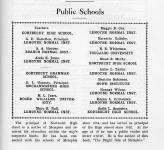 |
 |
Green. P. Hamilton
was a
native of Memphis and a product of the early Memphis education
system. He was associated with the school system since
1884 and became Principal of Kortrecht High School in 1892.
Hamilton Elementary, Junior High, and High Schools are named
in his honor. He is the author of
"The Bright Side of Memphis" and 2 other books.
As principal of Kortrecht High, he
organized the
first African American high school band in Memphis about 1900.
|
|
List of
Teachers |
G. P.
Hamilton |
|
|
|
|
|
|
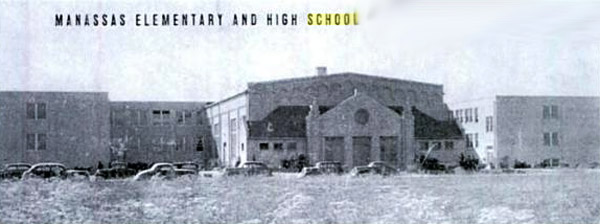 |
|
 |
|
1926 Manassas
Report Card - Front |
|
|
|
Manassas High
was established in 1899 and it was the first four-year accredited
"colored" high school in Shelby County. The first senior class
graduated in 1924. Manassas initiated the first sports program
among black schools in Memphis in 1924.
(Click here for the complete history of
Manassas.
PDF File. Please use the
Back Button to return to this page)
In the
1920's a teacher named Jimmie Lunceford taught music at Manassas.
His
high school band was so good that Lunceford quit his teaching job
and took the band out on the road. The Jimmie Lunceford Band was one
of the premiere touring big bands of the 1930's and 1940's, and
enjoyed success with recordings, as well. Isaac
Hayes also went to Manassas before going on to fame as a composer and
performer. |
|
 |
|
1926 Manassas
Report Card - Back |
|
|
|
|
Jimmie Lunceford
and the Jimmie Lunceford Band |
|
|
|
|
|
|
|
|
Melrose High
was established in 1890 and was the pride of the Orange
Mound neighborhood. The school was named after Dr. Melrose, a
philanthropist and humanitarian. Melrose became part of the
Memphis City Schools in 1919. By 1929 the building was
considered "a fire trap", and a new building was finally funded in
1937. By the time it opened in 1938, Park Avenue Schools and
Melrose had merged. |
|
|
|
|
 |
 |
|
|
Melrose High
1938 |
An
extremely rare 1939 post card featuring Melrose |
|
|
|
|
|
|
|
|
|
|
The Howe Institute
(now Lemoyne-Owen College) |
|
|
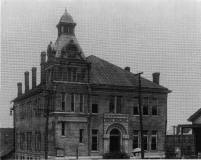 |
 |
 |
| |
A
rare 1892 photo of The Howe Institure |
Lemoyne
Class - 1871 |
|
 |
Founded in 1888 by Peter Howe, as Memphis' Baptist and Normal Institute, this was one of the earliest
private educational facilities for African Americans in
Memphis. In 1902
Thomas O. Fuller was named principal and under his
leadership "the school has gone forward by leaps and
bounds". T. O. Fuller State Park in Shelby
County is named for him. |
|
T. O. Fuller |
|
|
| |
 |
|
|
|
 |
|
T. O. Fuller 1925 |
|
|
|
Howe
Jr. College 1925 |
|
| |
 |
 |
|
A Postcard picturing The Howe Institute,
Circa 1910 |
A 1909 Brochure describing the history of The Howe
Institute |
|
|
|
|
|
|
|
|
 |
 |
 |
|
High School
Class, Circa 1910 |
First graduating
class at
Kortrecht High - 1891 |
8th Grade Class,
1912-13 |
|
|
|
|
|
 |
 |
 |
|
List of "Colored Schools"
teachers, 1881 |
"Colored
Industrial Class - Culinary",
1910 |
"Colored
Industrial Class - Shop", 1910 |
|
|
|
|
|
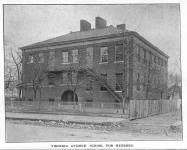 |
 |
 |
|
Virginia Avenue
School |
Books by Virginia
Broughton |
Kortrecht -
circa
1926 |
|
The
old Clay-Kortrecht Building
was renamed Virginia Av. |
First Black Woman in the South
to receive a college degree.. |
This may be a photo of just one homeroom at Kortrecht or the new
Booker T. Washington. |
|
|
|
|
 |
 |
 |
|
Kortrecht Grammar Faculty -
1910 |
No Information
??? |
Kortrecht -
1917 Diploma |
|
|
|
Very Rare!!! |
|
|
|
|
|
|
|
Historical Marker:
The first free
"colored" school in the city was opened in early 1863 in a barrack
building in South Memphis. In 1864 the U.S. Army issued a general order
authorizing its officers to help with these schools for the education of
freedmen. In 1865 there were 9 schools here. All were burned during the
May 1866 race riot. In 1868-69 there were again 9 schools in operation in
various locations in the city. One of these schools was located in this
area.
Note: That
first school was opened by Miss Fannie Kidder, "...a lady of
culture and high Christian character from Illinois". |
 |
|
|
|
|
|
|
|
 |
|
Harper's Weekly
Article 1866 |
|
The Race Riot of 1866
All
9 black schools were either burned or destroyed during these riots.
On May 1-2, 1866,
Memphis suffered its worst race riot in history. Some forty-six African
Americans and two whites died during the riot. Reports are that
seventy-five persons were injured, one hundred persons robbed, five women
raped, ninety-one homes burned, four churches and eight schools burned and
destroyed, and thousands of dollars in federal property destroyed.
The riot started after an alarm went out that African American soldiers
from Fort Pickering, on the south boundary of downtown Memphis, had killed
several policemen who tried to arrest a black soldier. In response to the
reports, Union General George Stoneman disarmed the soldiers and locked
them in their barracks, leaving nearby freedmen's settlements vulnerable
to the white mobs that soon attacked women, children, and defenseless men,
as well as the northern missionaries who served as ministers and teachers
for the freedmen.
The Memphis riots reflected the anger and frustration felt by many white
citizens and particularly former Confederates, who had suffered the agony
of a bitter defeat at the hands of a black and white Union army. The jobs
that were taken by freed blacks had formerly been the property of recent
immigrants - the poor Irish. That led to a bitterness between the
two groups which was made much more volatile by virtue of almost complete
Irish control of the police and fire departments.
Some
downtown businessmen participated in the mob because they resented the
hordes of penniless freedmen on the streets. Other rioters wanted revenge
for the Union occupation. The use of African American soldiers as
patrolmen with power to order whites to "move on" was especially galling
to many. Finally, the riots reflected the attitudes of most white citizens
toward the former slaves who were then free and soon demanding equal
rights. |
|
|
|
|
|
|
|
|
B. K. Sampson- 2nd
Principal of Clay School
Sarah Clark . Principal of Chelsea School
Early "Colored
Teachers": Mary Johnson - Mary Tyler - Elya Mitchell - Rose
Kinney - Graftil Moody - Maria Rankin - Mattie Clouston - Mrs. S. H.
Thompson - Olivia Davidson, Virginia Broughton.
Julia B. Hooks -
Memphis teacher, but known more
as an activist for civil rights than as an educator.
Ida B. Wells - Memphis teacher, but known more as an activist for civil rights than as an educator. |
|
|
|
The newspaper articles below are very interesting.
Click on the fragment to enlarge the complete article.
Most articles are PDF files - so please use
your Back Button to return to this page.
|
|
|
|
|
|
| Below:
1868 article about an Exhibition of the "Free Colored Schools"
in Memphis. |
|
| Below:
1868 report on enrollment of the "Colored Schools of Memphis" |
|
| |
|
 |
 |
| |
|
| |
|
| Below:
1868 article about the costs of "Freedmen's Schools" |
|
| Below:
1868 article on the state of "Our Colored Schools" |
|
| |
|
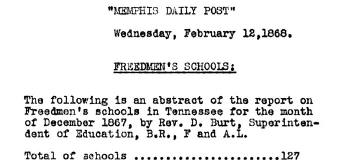 |
 |
| |
|
| |
|
| Below:
1869 Report of a visit to "Colored Schools" |
|
| Below:
1872 article about an exhibition of the "Colored Schools" in
Memphis. |
|
| |
|
|
 |
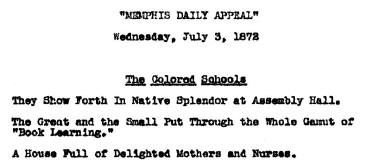 |
| |
|
| |
|
| Below:
1873 meeting about "colored" asking for better school
buildings and better teachers. |
|
| Below:
1874 Memphis Directory listing "Colored Schools" |
|
| |
|

|
 |
| |
|
| |
|
| Below:
Letter from C. C. Branch, Memphis teacher about "Colored"
Education. |
|
| Below:
Report on "Our Colored Schools" from Prof. J. H. Barnum, first Superintendent of
ColoredSchools. |
|
| |
|
 |
 |
| |
|
| |
|
|
Below:
1887 Letter from B. K.
Sampson, published in the newspaper, in retaliation to a
minister's "attack". |
|
|
Below:
1889 Article - a testimonial
and a rebuke about "Negro Education" in the South. |
|
| |
|
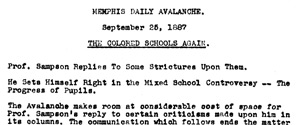 |
 |
| |
|
|
|
|
|
Below: The 1866 published
Statistics of the "Colored Schools of Memphis". |
|

|
|
|
|
Credits |
|
|
|
The
Historic-Memphis website does not intentionally post copyrighted
photos and material without permission or credit.
On
occasion a "non-credited" photo might possibly be posted because we
were unable to find a name to give credit. Because of the nature of
our non-commercial, non-profit, educational website, we strongly
believe that these photos would be considered "Fair Use. We have
certainly made no monetary gain, although those using this website
for historic or Genealogy research have certainly profited. If by
chance,
we have posted your copyrighted photo, please contact us, and we'll
remove it immediately, or we'll add your credit if that's your
choice. In the past, we have found that many photographers
volunteer to have their works included on these pages and we'll
also do that if you contact us with a photo that fits a particular
page. |
|
|
|
The "Historic-Memphis" website would like to acknowledge and thank the
following for their contributions which helped make this website
possible:
Memphis
Public Library, Memphis University Library, Memphis Law Library,
Memphis Commercial Appeal, Memphis Press Scimitar, Shelby County
Register of Deeds, Memphis City Schools, Memphis Business Men's
Club, Memphis Chamber of Commerce, Memphis City Park Commission,
Memphis Film Commision, Carnival Memphis, Memphis Historical
Railroad Page, Memphis Heritage Inc, Beale Street Historic District,
Cobblestone Historic District, Memphis Historic Districts, Vance
Lauderdale Family Archives, Tennessee State Archives, Library of
Congress, Kemmons Wilson Family, Richard S. Brashier, Lee Askew,
George Whitworth, Woody Savage and many individuals whose assistance is
acknowledged on the pages of their contributions. Special
thanks to Memphis Realtor, Joe Spake, for giving us carte blanche
access to his outstanding collection of contemporary Memphis photos.
We do not have high definition copies of the photos on these
pages. If anyone wishes to secure high definition photos,
you'll have to contact the photographer or the collector.
(To avoid any possibility of contributing to SPAM, we do not
maintain a file of email addresses for anyone who contacts us). |
|
|
|
|
|
Please visit the website that
sponsors this page
Historic Memphis Website |
|
|






















































